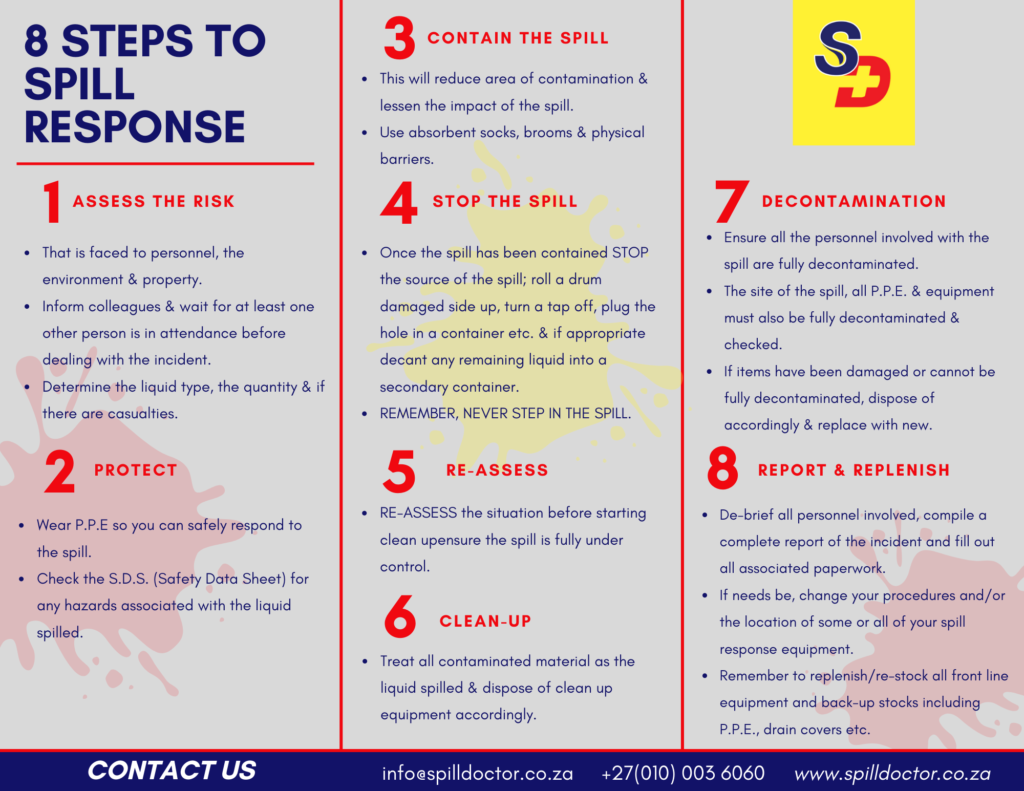What are the 3 steps to follow in the event of a spillage on site?

Spillages can happen in any workplace, and it's crucial to know how to respond quickly and effectively to minimize the potential hazards. Whether it's a chemical spill, an oil leak, or any other type of substance, following the correct steps can prevent further damage and ensure the safety of everyone involved. In this article, we will outline the three essential steps to follow in the event of a spillage on site.
Step 1: Assess the Situation
The first step in handling a spillage is to assess the situation. Take a moment to evaluate the type and quantity of the spilled substance. Is it hazardous? Is it flammable? Is it corrosive? Understanding the nature of the spill will enable you to determine the appropriate response and necessary precautions to take.
Step 2: Control and Contain the Spill
Once you have assessed the situation, the next step is to control and contain the spill. This means taking immediate action to prevent the spill from spreading further. If possible, shut off any equipment or machinery involved in the spill. Use barriers or absorbent materials to create a physical barrier around the affected area and prevent the spill from reaching drains, water sources, or sensitive environments.
Step 3: Clean up and Dispose of the Spill
After the spill is controlled and contained, it's time to clean up and dispose of the spilled substance properly. Equip yourself with the necessary personal protective equipment, such as gloves, goggles, and a respirator, if required. Follow the appropriate procedures for cleaning up the specific type of spill. Use absorbent materials, containment booms, or other specialized tools to collect the spilled substance. Dispose of the collected material according to the relevant regulations and guidelines.
Conclusion
Spillages on site can be dangerous and potentially harmful to both people and the environment. By following the three essential steps of assessing the situation, controlling and containing the spill, and properly cleaning up and disposing of the spilled substance, you can effectively manage and mitigate the risks associated with spills. Remember, taking prompt and appropriate action is crucial in preventing further accidents and ensuring the safety of everyone involved.
Frequently Asked Questions
1. What should I do if I don't know the nature of the spilled substance?
If you are unsure about the nature of the spilled substance, it is essential to prioritize your safety first. Keep a safe distance and alert the appropriate authorities or experts who can identify and handle the situation correctly.
2. How can I protect myself while handling a spill on site?
To protect yourself while handling a spill, always wear the appropriate personal protective equipment (PPE) recommended for the specific type of spill. This may include gloves, goggles, masks, or protective clothing. Additionally, ensure proper ventilation in the area and follow any safety protocols or guidelines provided by your organization.
3. Are there any specific regulations I need to follow when cleaning up a spill?
Yes, there are specific regulations and guidelines that govern the cleanup and disposal of different types of spills. These regulations vary depending on the nature of the spilled substance and the location. It is crucial to familiarize yourself with the relevant regulations and ensure compliance to avoid any legal and environmental consequences.
4. How can I prevent spills from happening in the first place?
Prevention is always better than cure when it comes to spills. To prevent spills from happening in the first place, make sure to handle and store hazardous substances correctly. Implement proper maintenance and inspection routines for equipment and machinery. Train employees on spill prevention and response procedures. By prioritizing preventive measures, you can minimize the chances of spills occurring and the potential risks associated with them.

Leave a Reply